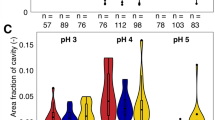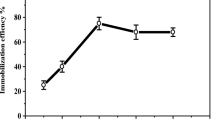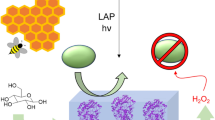Abstract
Catechol-modified alginate (AlgDA) samples with various catechol contents were synthesized and examined as adhesive materials. AlgDA exhibited high adhesive strength with mica and moderate adhesive strength with polymer resins, although this adhesiveness was not observed for sodium alginate. Moreover, AlgDA with a relatively low catechol content exhibited relatively high adhesive strength, unlike other catechol-modified polymer adhesives, presumably because the intramolecular aggregation of catechol units was suppressed in an aqueous solution. AlgDA residues were successfully removed from the used substrates by a simple water washing process. AlgDA is promising as a biobased adhesive material that contributes to a sustainable society.
This is a preview of subscription content, access via your institution
Access options
Subscribe to this journal
Receive 12 print issues and online access
$259.00 per year
only $21.58 per issue
Buy this article
- Purchase on Springer Link
- Instant access to full article PDF
Prices may be subject to local taxes which are calculated during checkout





Similar content being viewed by others
References
Wang S, Lu A, Zhang L. Recent advances in regenerated cellulose materials. Prog Polym Sci. 2016;53:169–206.
Kumar MNVA. Review of chitin and chitosan applications. React Funct Polym. 2000;46:1–27.
Webber RE, Shull KR. Strain dependence of the viscoelastic properties of alginate hydrogels. Macromolecules. 2004;37:6153–60.
Pawar SN, Edgar KJ. Alginate derivatization: a review of chemistry, properties and applications. Biomaterials. 2012;33:3279–305.
Donati I, Holtan S, Mørch YA, Borgogna M, Dentini M, Skjåk–Braek G. New hypothesis on the role of alternating sequences in calcium–alginate gels. Biomacromolecules. 2005;6:1031–40.
Zhang Y, Jiang G, Yu W, Liu D, Xu B. Microneedles fabricated from alginate and maltose for transdermal delivery of insulin on diabetic rats. Mater Sci Eng C. 2018;85:18–26.
Zheng A, Cao L, Liu Y, Wu J, Zeng D, Hu L, et al. Biocompatible silk/calcium silicate/sodium alginate composite scaffolds for bone tissue engineering. Carbohydr Polym. 2018;199:244–55.
Hou J, Li C, Guan Y, Zhang Y, Zhu XX. Enzymatically crosslinked alginate hydrogels with improved adhesion properties. Polym Chem. 2015;6:2204–13.
Bierhalz ACK, Silva MA, Kieckbusch TG. Natamycin release from alginate/pectin films for food packaging applications. J Food Eng. 2012;110:18–25.
Laffleur F, Küppers P. Adhesive alginate for buccal delivery in aphthous stomatitis. Carbohydr Res. 2019;477:51–7.
Lee C, Shin J, Lee JS, Byun E, Ryu JH, Um SH, et al. Bioinspired, calcium-free alginate hydrogels with tunable physical and mechanical properties and improved biocompatibility. Biomacromolecules. 2013;14:2004–13.
Lee BP, Messersmith PB, Israelachvili JN, Waite JH. Mussel-inspired adhesives and coating. Annu Rev Mater Res. 2011;41:99–132.
Aich P, An J, Yang B, Ko YH, Kim J, Murray J, et al. Self-assembled adhesive biomaterials formed by a genetically designed fusion protein. Chem Commun. 2018;54:12642–45.
Hofman AH, van Hees IA, Yang J, Kamperman M. Bioinspired underwater adhesives by using the supramolecular toolbox. Adv Mater. 2018;30:1704640.
Waite JH. Adhesion à la moule. Integr Comp Biol. 2002;42:1172–80.
Waite JH. Mussel adhesion-essential footwork. J Exp Biol. 2017;220:517–30.
Giuri D, Jacob KA, Ravarino P, Tomasini C. Boc-protection on l-DOPA: an easy way to promote underwater adhesion. Eur J Org Chem. 2020;46:7144–50.
Zhao H, Sun C, Stewart RJ, Waite JH. Cement proteins of the tube-building polychaete phragmatopoma californica. J Biol Chem. 2005;280:42938–44.
Shin M, Shin JY, Kim K, Yang B, Han JW, Kim NK, et al. The position of lysine controls the catechol-mediated surface adhesion and cohesion in underwater mussel adhesion. J Colloid Interface Sci. 2020;563:168–76.
Yan S, Wang W, Li X, Yun W, Zhang K, Li G, et al. Preparation of mussel-inspired injectable hydrogels based on dual-functionalized alginate with improved adhesive, self-healing, and mechanical properties. J Mater Chem B. 2018;6:6377–90.
Lee H, Dellatore SM, Miller WM, Messersmith PB. Mussel-inspired surface chemistry for multifunctional coatings. Science. 2007;318:426–30.
Lee SB, Gonzalez-Cabezas C, Kim KM, Kim KN, Kuroda K. Catechol-functionalized synthetic polymer as a dental adhesive to contaminated dental surface for a composite restoration. Biomacromolecules. 2015;16:2265–75.
Cheng B, Yu J, Arisawa T, Hayashi K, Richardson JJ, Shibuta Y, et al. Ultrastrong underwater adhesion on diverse substrates using non-canonical phenolic groups. Nat Commun. 2022;13:1892.
Duarte AP, Coelho JF, Bordado JC, Cidade MT, Gil MH. Surgical adhesives: systematic review of the main types and development forecast. Prog Polym Sci. 2012;37:1031–50.
Du X, Hou Y, Wu L, Li S, Yu A, Kong D, et al. An anti-infective hydrogel adhesive with non-swelling and robust mechanical properties for sutureless wound closure. J Mater Chem B. 2020;8:5682–93.
Cholewinsk A, Yang FK, Zhao B. Underwater contact behavior of alginate and catechol-conjugated alginate hydrogel beads. Langmuir. 2017;33:8353–61.
Suzuki F, Sato E, Matsumoto A. Thermal degradation behavior of polymers containing a tert-butoxycarbonyl group in the side chain and application to dismantlable adhesion materials. J Adhesion Soc Jpn. 2017;53:4–10.
Sato E, Iki S, Yamanishi K, Horibe H, Matsumoto A. Dismantlable adhesion properties of reactive acrylic copolymers resulting from cross-linking and gas evolution. J Adhesion. 2017;93:811–22.
Sogawa H, Ifuku N, Numata K. 3,4-Dihydroxyphenylalanine (DOPA)-containing silk fibroin: its enzymatic synthesis and adhesion properties. Sci Eng. 2019;5:5644–651.
Burke KA, Roberts DC, Kaplan DL. Silk fibroin aqueous-based adhesives inspired by mussel adhesive proteins. Biomacromolecules. 2016;17:237–45.
Lv C, Li L, Jiao Z, Yan H, Wang Z, Wu Z, et al. Improved hemostatic effects by Fe3+ modified biomimetic PLLA cotton-like mat via sodium alginate grafted with dopamine. Bioact Mater. 2021;6:2346–59.
Hu Y, Su X, Lei Y, Wang Y. A novel anti-calcification method for bioprosthetic heart valves using dopamine-modified alginate. Polym Bull. 2019;76:1423–34.
Zhang S, Wang R, Wang G. Impact of dopamine oxidation on dopamineric neurodegeneration. ACS Chem Neurosci. 2019;10:945–53.
Flores-Hernánedes CG, Cornejo-Villegas MDLA, Moreno-Martell A, Del Real A. Synthesis of a biodegradable polymer of poly (sodium alginate/ethyl acetate). Polymers. 2021;13:504.
Pereira R, Tojeira A, Vas DC, Mendes A, Bártolo P. Preparation and characterization of films based on alginate and aloe vera. Int J Polym Anal Charact. 2011;16:449–64.
Yoon J, Oh DX, Jo C, Lee J, Hwang DS. Improvement of desolvation and resilience of alginate binders for Si-based anodes in a lithium ion battery by calcium-mediated cross-linking. Phys Chem Chem Phys. 2014;16:25628–35.
Yu M, Deming TJ. Synthetic polypeptide mimics of marine adhesives. Macromolecules. 1998;31:4739–45.
Yamada K, Chen T, Kumar G, Vesnovsky O, Topoleski LDT, Payne GF. Chitosan based water-resistant adhesive. Analogy to mussel glue. Biomacromolecules. 2000;1:252–8.
Acknowledgements
We thank Prof. Takashi Miyata, Prof. Akifumi Kawamura and Ms. Chika Hajime (Kansai University, Japan) for letting us use a tensile testing machine and Prof. Hiroshi Tamura, Prof. Tetsuya Furuike and Mr. Taisei Iwasa (Kansai University, Japan) for letting us use an SEC instrument.
Funding
This research was financially supported by JSPS KAKENHI Grant Number JP22H04565 (Grant-in-Aid for Scientific Research on Innovative Areas of “Aquatic Functional Materials”, Area No. 6104), Shorai Foundation for Science and Technology, and Yashima Environment Technology Foundation. This research used computational resources under the Collaborative Research Program for Young•Women Scientists provided by the Academic Center for Computing and Media Studies, Kyoto University.
Author information
Authors and Affiliations
Corresponding authors
Ethics declarations
Conflict of interest
The authors declare no competing interests.
Additional information
Publisher’s note Springer Nature remains neutral with regard to jurisdictional claims in published maps and institutional affiliations.
Supplementary information
Rights and permissions
Springer Nature or its licensor (e.g. a society or other partner) holds exclusive rights to this article under a publishing agreement with the author(s) or other rightsholder(s); author self-archiving of the accepted manuscript version of this article is solely governed by the terms of such publishing agreement and applicable law.
About this article
Cite this article
Inata, S., Sogawa, H. & Sanda, F. Water-soluble alginate–based adhesive: catechol modification and adhesion properties. Polym J 55, 785–795 (2023). https://doi.org/10.1038/s41428-023-00770-z
Received:
Revised:
Accepted:
Published:
Issue Date:
DOI: https://doi.org/10.1038/s41428-023-00770-z



